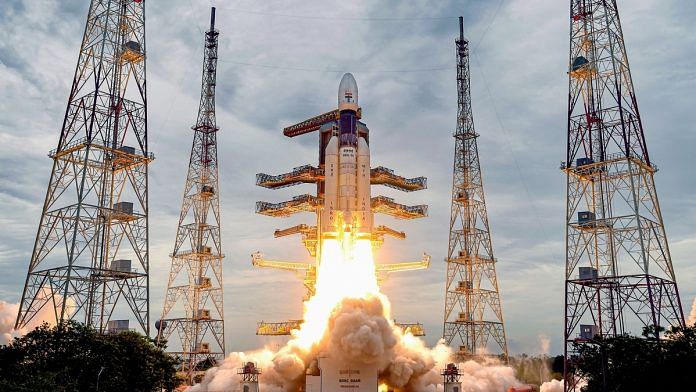The Rig Veda mentions that the moon’s glow is reflected light from the sun. Other texts mention the importance of the moon in our daily lives. Amarakosha, the oldest extant Sanskrit thesaurus, lists 20 names for the moon. There are at least 85 variations that are used as names by both men and women. Yet, till Monday the 22nd of July 2019, the moon remained a distant dream for a civilisation that has long had knowledge about planets and satellites but lacked the cutting edge technology needed to bridge the distance between earthly mortals and heavenly stars.
The successful launch of Indian Space Research Organisation’s Chandrayaan 2, an ambitious mission which is scheduled to culminate in a soft-landing of the onboard rover on or around the south pole of moon, reaffirms India’s emergence as a major player in the race for dominance in space that has seen China setting up a separate force and investing heavily in seeking to emerge as the new leader in this domain, displacing America. Meanwhile, the US plans to send a third manned mission to moon in the next five years.
Half a century after people around the world, glued to their radio and television sets, heard Neil Armstrong say “a small step for (a) man, a giant leap for mankind” as he set foot on the lunar surface, every country aspires to do the moonwalk; India is almost there and can legitimately claim membership of the super exclusive space club, if everything goes as planned, at 2:58 am on 7th September. After India’s successful Mars mission with Mangalayan in 2014 and the anti-satellite missile test in March this year, it would be a success that none would be able to deny.
Also read: Chandrayaan-2 ‘cheaper than Interstellar’, but India’s space ambition can’t be about cost
There is, of course, the possibility of failure over the next 48 days. Israel’s spacecraft came close to a successful landing on moon and faltered at the last moment. American missions have similarly faltered and failed, as have Chinese and before that Russian missions. But failure, even if it were to occur, would at best be a stumbling block. India, through ISRO, has demonstrated ability and capacity in pushing through the frontiers of space with ballistic missile technology and anti-satellite (ASAT) technology. India is now a globally recognised platform for launching satellites.
It is for technical experts to deal with the science of Chandrayaan 2 and for space experts to elaborate on what a successful moon-landing would mean in terms of Indian capacities in an area that will increasingly come to dominate strategic interests as this century unwinds its way to the midway mark. Exploring the lunar surface and atmosphere to study their composition has its own import; there is no reason why any one country should be allowed monopoly control over lunar resources. The moon must remain, in a manner of speaking, beyond both belt and road. India missed out on staking a claim in Antarctica; it can’t afford to let other powers to colonise moon.
That apart, it is the rapid militarisation of space that should concern everybody. India cannot be blind to the threat this poses to its own national security. The thousands of satellites orbiting in space are crucial to navigation, telecommunications, banking transactions, weather forecast and a host of activities that are integral to both national and commercial interests. The importance of these ‘assets’ and the need to protect them from offensive weapons like ASAT cannot be over-emphasised.
Also read: Chandrayaan-2 lifts off, expected to land on Moon in September
As technology evolves and upgrades itself with every passing day, the threat to space assets, and hence national security, also continuously transmogrifies, posing an ever-increasing risk to countries and continents. The Outer Space Treaty of 1967 stands antiquated – the emerging reality goes way beyond space-based weapons of mass destruction.
There is nothing romantic or adventurous about foraying into space; it is hard-nosed strategic interest that fuels space missions. The Americans won the space race during the Cold War and the subsequent propaganda provided a cover for far-sighted motives that have become apparent only in recent decades. It was not the much goggled-over ‘moon stone’ the US was after, nor was it about Russia figuring out whether dogs can survive a journey through space. In the same vein, it is not to prove the Rig Veda right that India is, figuratively speaking, seeking a slice of the moon.
From Aryabhatta, named after the great Indian astronomer who mapped the vast skies dotted with celestial bodies, the first satellite launched by ISRO from USSR’s Kapustin Yar on 19th April 1975, India has come a long way. As a rising power it now aims for the moon.
This piece was originally published on the website of the Observer Research Foundation.







This mission created thousands of job’s for scientists, many universities and companies.indian space budget is lowest 0.06% of GDP.
This project success will provide India with technology necessary for Landing on other planets, asteroid’s that will help in mineral mining.
I request people’s to support space mining because this tech will pave way for ISRO business plans.
Why waste money and resources over superfluous achievements. There are so many citizens who don’t have access to clean water, basic sanitation and roof over the head. There is need for infrastructure everywhere .
What are priorities of leadership, clearly none.
At 0.06% of GDP India is spending very very low on space budget.which helps is creating scientists,crores of students in colleges who take science should be provided with destination that is ISRO and it’s supplier companies and many more world organisations which provide job’s because students were trained at ISRO.
Full marks to our scientists. Let their tribe increase.
50 years behind in the race.